PFA 401: Autism Reflection on Personal Experiences
VerifiedAdded on 2022/09/28
|5
|1270
|23
Report
AI Summary
This report reflects on the student's personal experiences with autism spectrum disorder (ASD), analyzing how these experiences shaped their initial views and beliefs. The student recounts an encounter with a boy with ASD, which challenged their preconceptions about the disorder. The report details how their understanding evolved, influenced by learning modules that addressed risk factors, the broad spectrum of the disorder, and its causes. The student also discusses societal stigmas and the importance of a person-first perspective in understanding and addressing the challenges faced by individuals with autism. The report concludes by emphasizing the need to challenge societal beliefs and promote treatments for those with ASD.
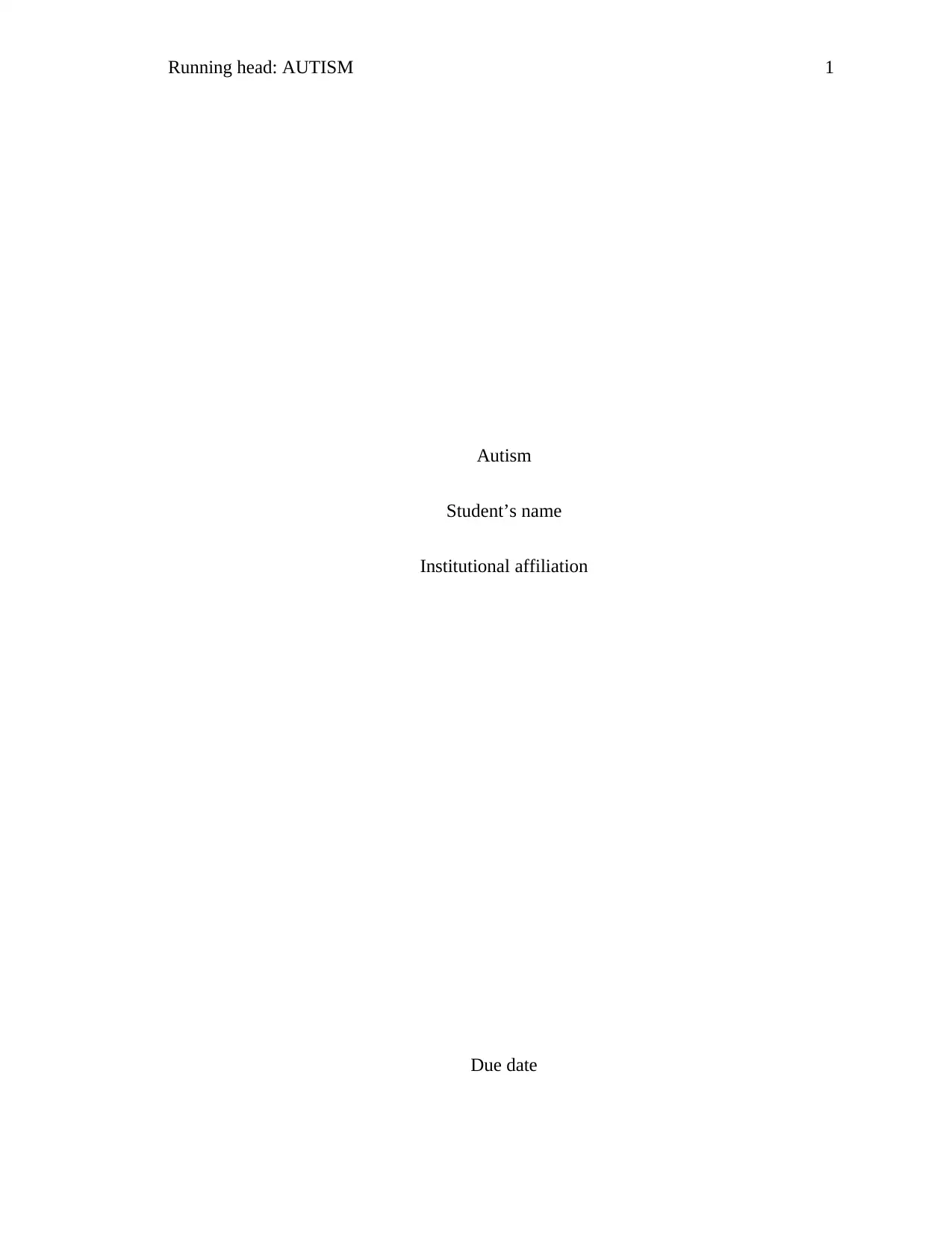
Running head: AUTISM 1
Autism
Student’s name
Institutional affiliation
Due date
Autism
Student’s name
Institutional affiliation
Due date
Paraphrase This Document
Need a fresh take? Get an instant paraphrase of this document with our AI Paraphraser
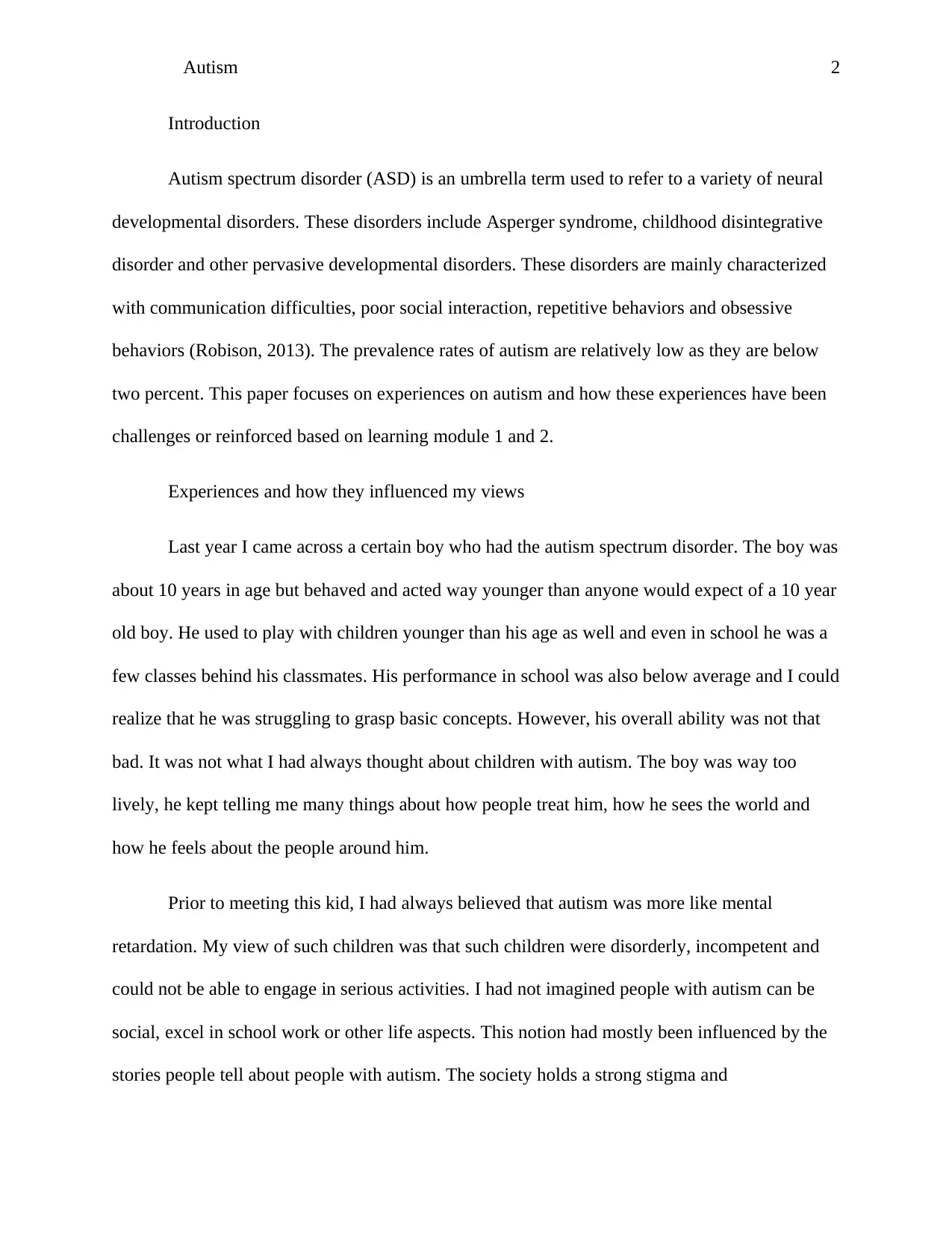
Autism 2
Introduction
Autism spectrum disorder (ASD) is an umbrella term used to refer to a variety of neural
developmental disorders. These disorders include Asperger syndrome, childhood disintegrative
disorder and other pervasive developmental disorders. These disorders are mainly characterized
with communication difficulties, poor social interaction, repetitive behaviors and obsessive
behaviors (Robison, 2013). The prevalence rates of autism are relatively low as they are below
two percent. This paper focuses on experiences on autism and how these experiences have been
challenges or reinforced based on learning module 1 and 2.
Experiences and how they influenced my views
Last year I came across a certain boy who had the autism spectrum disorder. The boy was
about 10 years in age but behaved and acted way younger than anyone would expect of a 10 year
old boy. He used to play with children younger than his age as well and even in school he was a
few classes behind his classmates. His performance in school was also below average and I could
realize that he was struggling to grasp basic concepts. However, his overall ability was not that
bad. It was not what I had always thought about children with autism. The boy was way too
lively, he kept telling me many things about how people treat him, how he sees the world and
how he feels about the people around him.
Prior to meeting this kid, I had always believed that autism was more like mental
retardation. My view of such children was that such children were disorderly, incompetent and
could not be able to engage in serious activities. I had not imagined people with autism can be
social, excel in school work or other life aspects. This notion had mostly been influenced by the
stories people tell about people with autism. The society holds a strong stigma and
Introduction
Autism spectrum disorder (ASD) is an umbrella term used to refer to a variety of neural
developmental disorders. These disorders include Asperger syndrome, childhood disintegrative
disorder and other pervasive developmental disorders. These disorders are mainly characterized
with communication difficulties, poor social interaction, repetitive behaviors and obsessive
behaviors (Robison, 2013). The prevalence rates of autism are relatively low as they are below
two percent. This paper focuses on experiences on autism and how these experiences have been
challenges or reinforced based on learning module 1 and 2.
Experiences and how they influenced my views
Last year I came across a certain boy who had the autism spectrum disorder. The boy was
about 10 years in age but behaved and acted way younger than anyone would expect of a 10 year
old boy. He used to play with children younger than his age as well and even in school he was a
few classes behind his classmates. His performance in school was also below average and I could
realize that he was struggling to grasp basic concepts. However, his overall ability was not that
bad. It was not what I had always thought about children with autism. The boy was way too
lively, he kept telling me many things about how people treat him, how he sees the world and
how he feels about the people around him.
Prior to meeting this kid, I had always believed that autism was more like mental
retardation. My view of such children was that such children were disorderly, incompetent and
could not be able to engage in serious activities. I had not imagined people with autism can be
social, excel in school work or other life aspects. This notion had mostly been influenced by the
stories people tell about people with autism. The society holds a strong stigma and
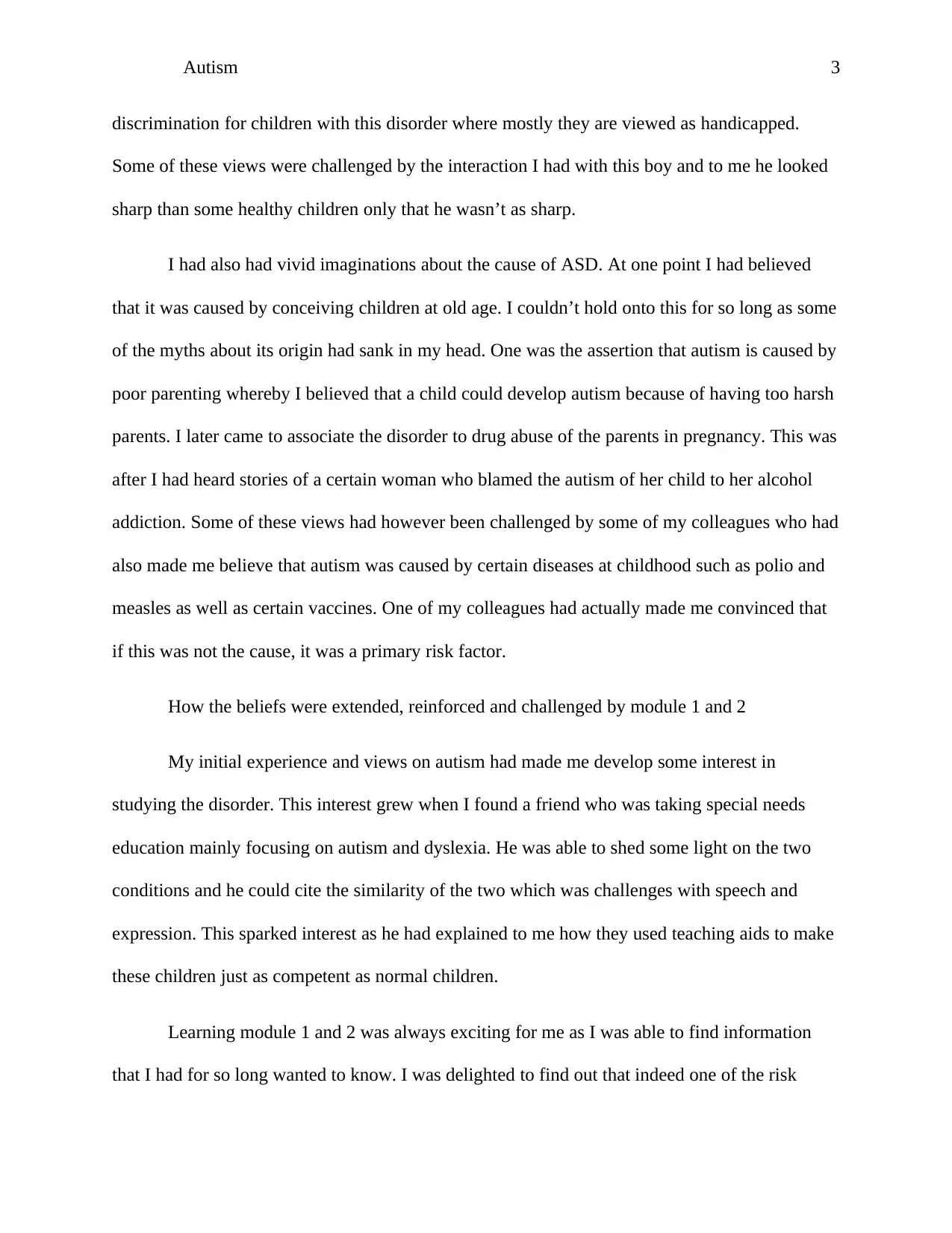
Autism 3
discrimination for children with this disorder where mostly they are viewed as handicapped.
Some of these views were challenged by the interaction I had with this boy and to me he looked
sharp than some healthy children only that he wasn’t as sharp.
I had also had vivid imaginations about the cause of ASD. At one point I had believed
that it was caused by conceiving children at old age. I couldn’t hold onto this for so long as some
of the myths about its origin had sank in my head. One was the assertion that autism is caused by
poor parenting whereby I believed that a child could develop autism because of having too harsh
parents. I later came to associate the disorder to drug abuse of the parents in pregnancy. This was
after I had heard stories of a certain woman who blamed the autism of her child to her alcohol
addiction. Some of these views had however been challenged by some of my colleagues who had
also made me believe that autism was caused by certain diseases at childhood such as polio and
measles as well as certain vaccines. One of my colleagues had actually made me convinced that
if this was not the cause, it was a primary risk factor.
How the beliefs were extended, reinforced and challenged by module 1 and 2
My initial experience and views on autism had made me develop some interest in
studying the disorder. This interest grew when I found a friend who was taking special needs
education mainly focusing on autism and dyslexia. He was able to shed some light on the two
conditions and he could cite the similarity of the two which was challenges with speech and
expression. This sparked interest as he had explained to me how they used teaching aids to make
these children just as competent as normal children.
Learning module 1 and 2 was always exciting for me as I was able to find information
that I had for so long wanted to know. I was delighted to find out that indeed one of the risk
discrimination for children with this disorder where mostly they are viewed as handicapped.
Some of these views were challenged by the interaction I had with this boy and to me he looked
sharp than some healthy children only that he wasn’t as sharp.
I had also had vivid imaginations about the cause of ASD. At one point I had believed
that it was caused by conceiving children at old age. I couldn’t hold onto this for so long as some
of the myths about its origin had sank in my head. One was the assertion that autism is caused by
poor parenting whereby I believed that a child could develop autism because of having too harsh
parents. I later came to associate the disorder to drug abuse of the parents in pregnancy. This was
after I had heard stories of a certain woman who blamed the autism of her child to her alcohol
addiction. Some of these views had however been challenged by some of my colleagues who had
also made me believe that autism was caused by certain diseases at childhood such as polio and
measles as well as certain vaccines. One of my colleagues had actually made me convinced that
if this was not the cause, it was a primary risk factor.
How the beliefs were extended, reinforced and challenged by module 1 and 2
My initial experience and views on autism had made me develop some interest in
studying the disorder. This interest grew when I found a friend who was taking special needs
education mainly focusing on autism and dyslexia. He was able to shed some light on the two
conditions and he could cite the similarity of the two which was challenges with speech and
expression. This sparked interest as he had explained to me how they used teaching aids to make
these children just as competent as normal children.
Learning module 1 and 2 was always exciting for me as I was able to find information
that I had for so long wanted to know. I was delighted to find out that indeed one of the risk
⊘ This is a preview!⊘
Do you want full access?
Subscribe today to unlock all pages.

Trusted by 1+ million students worldwide
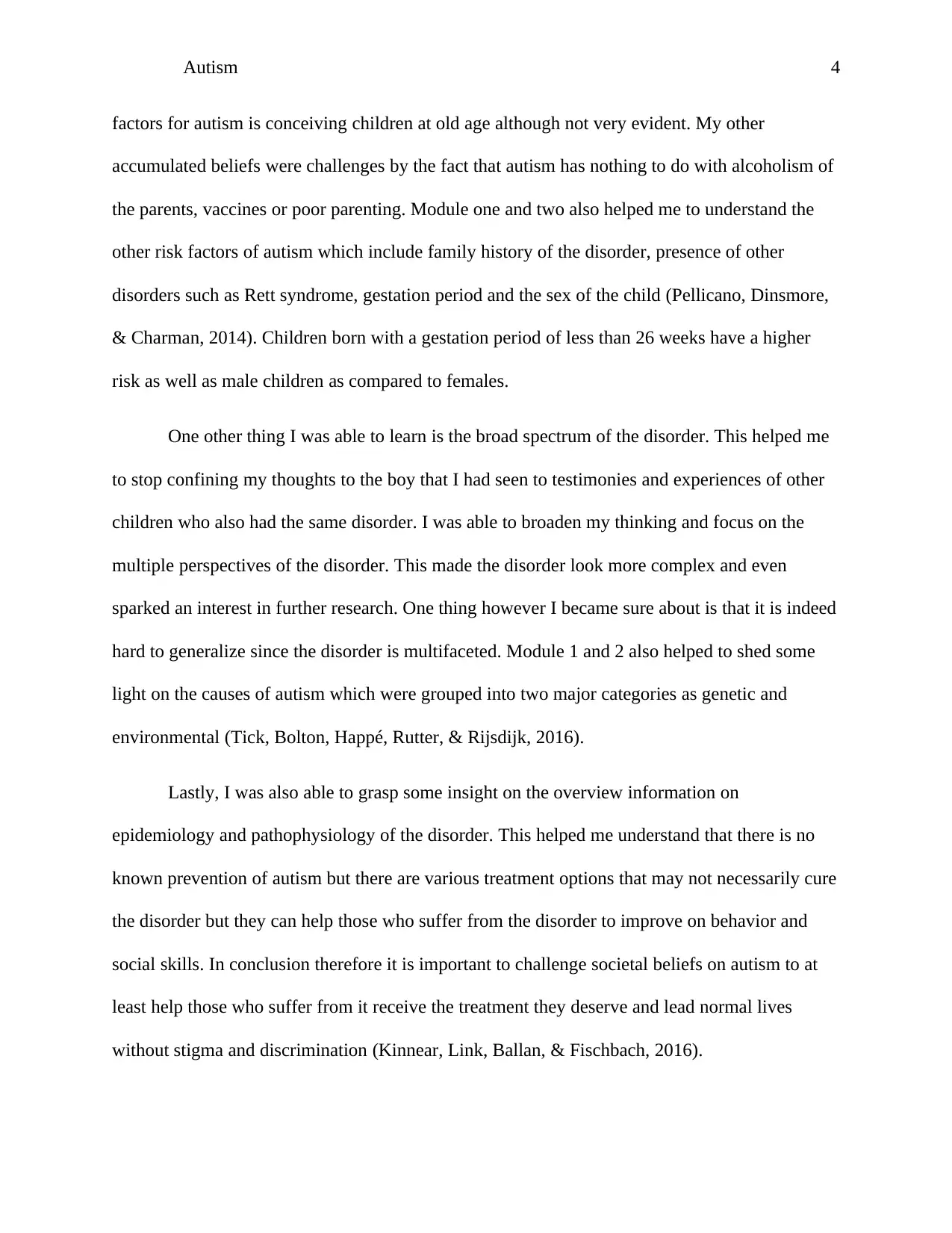
Autism 4
factors for autism is conceiving children at old age although not very evident. My other
accumulated beliefs were challenges by the fact that autism has nothing to do with alcoholism of
the parents, vaccines or poor parenting. Module one and two also helped me to understand the
other risk factors of autism which include family history of the disorder, presence of other
disorders such as Rett syndrome, gestation period and the sex of the child (Pellicano, Dinsmore,
& Charman, 2014). Children born with a gestation period of less than 26 weeks have a higher
risk as well as male children as compared to females.
One other thing I was able to learn is the broad spectrum of the disorder. This helped me
to stop confining my thoughts to the boy that I had seen to testimonies and experiences of other
children who also had the same disorder. I was able to broaden my thinking and focus on the
multiple perspectives of the disorder. This made the disorder look more complex and even
sparked an interest in further research. One thing however I became sure about is that it is indeed
hard to generalize since the disorder is multifaceted. Module 1 and 2 also helped to shed some
light on the causes of autism which were grouped into two major categories as genetic and
environmental (Tick, Bolton, Happé, Rutter, & Rijsdijk, 2016).
Lastly, I was also able to grasp some insight on the overview information on
epidemiology and pathophysiology of the disorder. This helped me understand that there is no
known prevention of autism but there are various treatment options that may not necessarily cure
the disorder but they can help those who suffer from the disorder to improve on behavior and
social skills. In conclusion therefore it is important to challenge societal beliefs on autism to at
least help those who suffer from it receive the treatment they deserve and lead normal lives
without stigma and discrimination (Kinnear, Link, Ballan, & Fischbach, 2016).
factors for autism is conceiving children at old age although not very evident. My other
accumulated beliefs were challenges by the fact that autism has nothing to do with alcoholism of
the parents, vaccines or poor parenting. Module one and two also helped me to understand the
other risk factors of autism which include family history of the disorder, presence of other
disorders such as Rett syndrome, gestation period and the sex of the child (Pellicano, Dinsmore,
& Charman, 2014). Children born with a gestation period of less than 26 weeks have a higher
risk as well as male children as compared to females.
One other thing I was able to learn is the broad spectrum of the disorder. This helped me
to stop confining my thoughts to the boy that I had seen to testimonies and experiences of other
children who also had the same disorder. I was able to broaden my thinking and focus on the
multiple perspectives of the disorder. This made the disorder look more complex and even
sparked an interest in further research. One thing however I became sure about is that it is indeed
hard to generalize since the disorder is multifaceted. Module 1 and 2 also helped to shed some
light on the causes of autism which were grouped into two major categories as genetic and
environmental (Tick, Bolton, Happé, Rutter, & Rijsdijk, 2016).
Lastly, I was also able to grasp some insight on the overview information on
epidemiology and pathophysiology of the disorder. This helped me understand that there is no
known prevention of autism but there are various treatment options that may not necessarily cure
the disorder but they can help those who suffer from the disorder to improve on behavior and
social skills. In conclusion therefore it is important to challenge societal beliefs on autism to at
least help those who suffer from it receive the treatment they deserve and lead normal lives
without stigma and discrimination (Kinnear, Link, Ballan, & Fischbach, 2016).
Paraphrase This Document
Need a fresh take? Get an instant paraphrase of this document with our AI Paraphraser
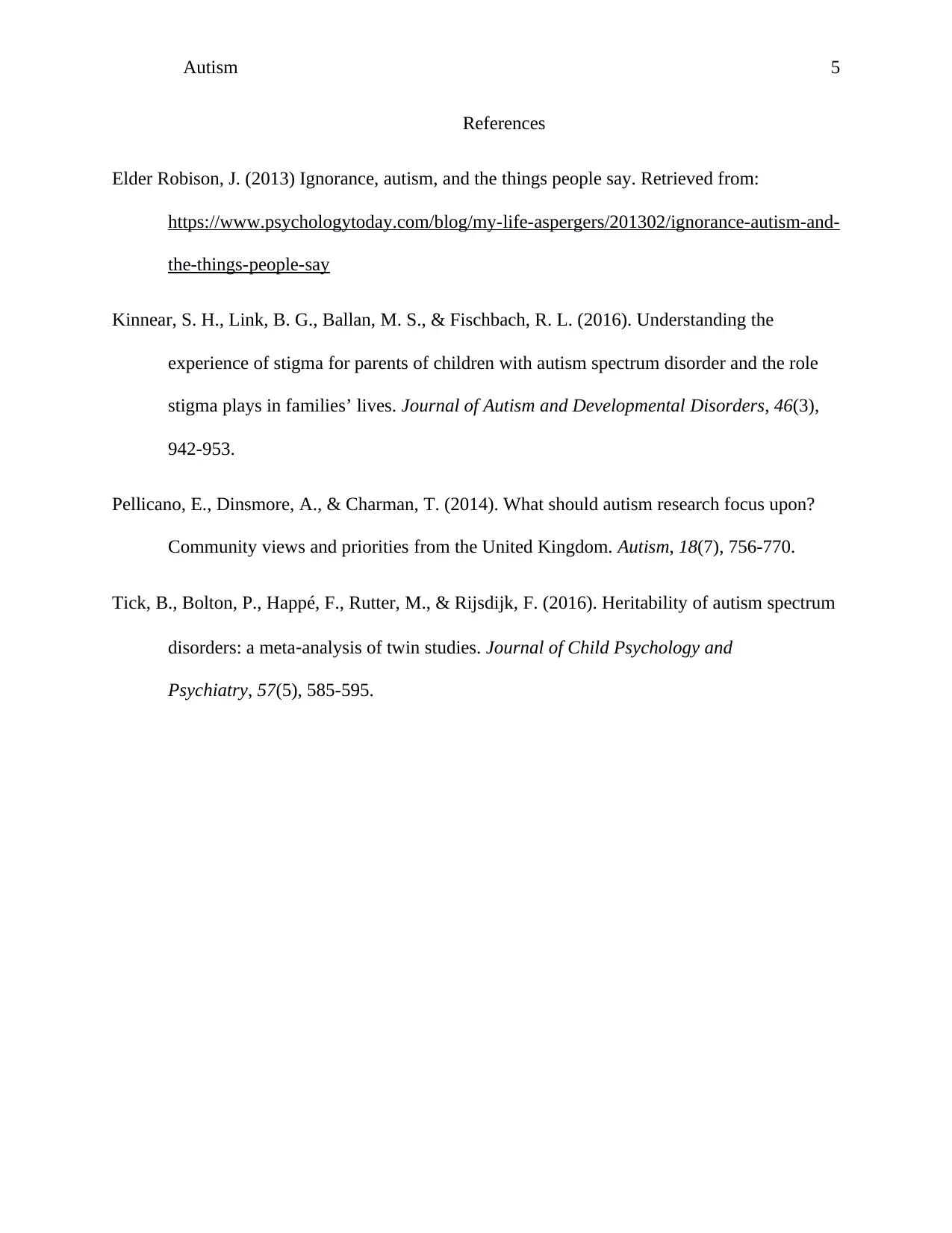
Autism 5
References
Elder Robison, J. (2013) Ignorance, autism, and the things people say. Retrieved from:
https://www.psychologytoday.com/blog/my-life-aspergers/201302/ignorance-autism-and-
the-things-people-say
Kinnear, S. H., Link, B. G., Ballan, M. S., & Fischbach, R. L. (2016). Understanding the
experience of stigma for parents of children with autism spectrum disorder and the role
stigma plays in families’ lives. Journal of Autism and Developmental Disorders, 46(3),
942-953.
Pellicano, E., Dinsmore, A., & Charman, T. (2014). What should autism research focus upon?
Community views and priorities from the United Kingdom. Autism, 18(7), 756-770.
Tick, B., Bolton, P., Happé, F., Rutter, M., & Rijsdijk, F. (2016). Heritability of autism spectrum
disorders: a meta‐analysis of twin studies. Journal of Child Psychology and
Psychiatry, 57(5), 585-595.
References
Elder Robison, J. (2013) Ignorance, autism, and the things people say. Retrieved from:
https://www.psychologytoday.com/blog/my-life-aspergers/201302/ignorance-autism-and-
the-things-people-say
Kinnear, S. H., Link, B. G., Ballan, M. S., & Fischbach, R. L. (2016). Understanding the
experience of stigma for parents of children with autism spectrum disorder and the role
stigma plays in families’ lives. Journal of Autism and Developmental Disorders, 46(3),
942-953.
Pellicano, E., Dinsmore, A., & Charman, T. (2014). What should autism research focus upon?
Community views and priorities from the United Kingdom. Autism, 18(7), 756-770.
Tick, B., Bolton, P., Happé, F., Rutter, M., & Rijsdijk, F. (2016). Heritability of autism spectrum
disorders: a meta‐analysis of twin studies. Journal of Child Psychology and
Psychiatry, 57(5), 585-595.
1 out of 5
Related Documents
Your All-in-One AI-Powered Toolkit for Academic Success.
+13062052269
info@desklib.com
Available 24*7 on WhatsApp / Email
![[object Object]](/_next/static/media/star-bottom.7253800d.svg)
Unlock your academic potential
Copyright © 2020–2025 A2Z Services. All Rights Reserved. Developed and managed by ZUCOL.





